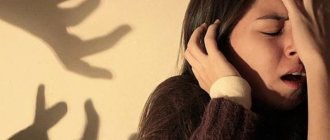What is fear of butterflies
What is the fear of butterflies called? The answer to this question is not known to many. Lepidopterophobia means fear of butterflies and moths. People with such phobias develop unpleasant feelings when being near insects. They become especially scared when the butterfly begins to touch the body with its wings. In some cases, a person may experience panic attacks at the mere sight of an insect. For example, when you are in a museum, you become afraid of an insect that is pinned with an entomological pin. The reaction may vary. At a minimum, for someone who is afraid of butterflies, there may be a slight dislike, or at most, there will be a desire to immediately hide.
Insect phobia is quite rare, unlike other entomophobias. This is due to the fact that other insects have a more terrifying appearance and are capable of causing direct harm to humans. Bees cause an allergic reaction, and some types of spiders secrete poisons. For these reasons, fears can be justified by psychological reasons, previous experiences, including on the physical plane.
What is lepidopterophobia?
Lepidopterophobia in psychology and psychiatry is the name given to the uncontrollable fear of butterflies and moths. The name of the disorder comes from the Greek. Λεπίδος - scales, πτερόν - wing and φόβος - fear. Another name for this phobia is mottephobia.
It would seem, what’s so scary about butterflies? When a person is afraid of spiders, cockroaches, centipedes, bees or wasps, this can still be understood. These insects are either dangerous or very unsightly looking. But how can beautiful, colorful creatures fluttering from flower to flower cause fear and disgust in someone? After all, they do not bite and do not harm people.
However, the human psyche is full of secrets and mysteries. The underlying causes of some phobias are not yet fully understood. But psychologists know that butterflies are not the strangest object to fear. There are also much more surprising phobias.
Lepidopterophobia is much less common than many other types of zoophobia and insectophobia (fear of insects). People are more often afraid of spiders, ants, bees, wasps, bumblebees and other insects. Some people have a fear of moths.
Cause of fear
It remains a mystery to many why people are afraid of butterflies. There can be many reasons for this phenomenon. As a rule, a phobia is formed against the background of chronic stress and increased anxiety of a person. Mental disorders that differ in the nature of their origin also lead to diseases. Children are at risk. For them, it is enough to hear a scary story about butterflies. In films or books, an insect may be offered the role of a negative hero. It is at this stage that a person develops a fear of butterflies.
If the parents react incorrectly, the child develops a phobia. Children do not always know how to behave correctly with insects; they are afraid of them, and adults respond with aggression. Afterwards, such fears haunt a person throughout his life. Here it takes time to explain to the child that moths are cute creatures that do not wish harm to people, they simply live their lives, interact with other living beings, including humans.
There is no need to chase away the butterfly at the same moment. It is enough to place it on your finger, thereby showing the creation of nature to the child. Children tend to copy the behavior of adults, for this reason it is better not to demonstrate aggression towards the outside world.
Rare cases include the development of lipidopetrophobia in children who grow up in a family where they collect butterflies. The following picture causes stress for a child: adults mock an insect, pierce its wings, hurt a butterfly. The child begins to empathize with living nature and lets everything pass through himself. Therefore, when he sees an insect, fear may arise at the subconscious level, and hostility may form.
Where does the fear of butterflies come from?
Phobia is one of the signs of neurosis. A prerequisite for the development of fear is a certain personality make-up. People suffering from mottephobia have high anxiety, emotional lability (instability), and excessive sensitivity.
Fear of butterflies occurs under the influence of a number of factors:
- chronic stress;
- negative experience of encountering an insect;
- mental disorder;
- hypersensitivity to touch.
Lepidoptrephobia is caused by childhood trauma. The first meeting with a butterfly brought unpleasant emotions that lasted for the rest of my life. Sometimes parents perpetuate fear through incorrect behavior. They either themselves are afraid of the insect and show destructive emotions in front of the child, or remind him that he was scared.
Often children in families of butterfly collectors suffer from lepidoptrephobia. They see an insect being impaled on a needle. Shock transforms into a feeling of disgust and disgust. A trace in the psyche can remain after watching a horror film, some unpleasant images, or listening to scary stories.
How to determine the disease
There are signs that indicate a fear of butterflies. Such people avoid contact with nature; when going to the forest or lawn, they develop a feeling of fear. Unpleasant sensations appear at the dacha, where butterflies circle nearby. A person associates a phobia with his vacation spot.
An individual who has a fear of butterflies is characterized by a sharp negative reaction not only at the sight of a moth, but also when directly touching the body with its wings. Unpleasant sensations arise from the scaly legs of the insect.
The most severe form of the disease includes fear or sudden panic attacks at the sight of a moth. As soon as an insect appears near such a person, he wants to immediately hide, hide, he is uncomfortable being in the same space as a butterfly. The first signs of fear include dilated pupils, trembling hands and knees, excessive sweating, and restricted movements.
How does a phobia of butterflies manifest?
Lepidopterophobia is manifested by the following psychological symptoms:
- disgust, hostility towards butterflies;
- increased anxiety when in contact with a butterfly;
- desire to hide;
- avoiding contact with the subject of fear (afraid to visit museums, watch encyclopedias, films);
- desire to destroy a butterfly;
- fear of outdoor recreation, in the forest;
- fear of leaving the house;
- wearing closed clothing;
- treating the house with chemicals against insects.
Somatic manifestations of phobia:
- nausea;
- headache;
- dizziness;
- body pain;
- muscle tension;
- problems with coordination;
- sweating;
- lethargy of the legs;
- shiver;
- dilated pupils.
In direct contact with a butterfly, a person falls into a stupor or, conversely, behaves inappropriately and hyperactively. Trying to escape from or destroy an insect, a person can cause harm to himself and others, for example, by running in front of a car or setting something on fire.
Forms of manifestation of the disease
If a person begins to be afraid of butterflies, then he tries to avoid meeting them. He no longer wants to go to his summer cottage, spend time with friends and family in nature, or visit the forest. When meeting an insect, a person who has a phobia reacts sharply to the situation, quickly disappears from sight, becomes harsh in his statements, and develops aggression.
Often, relatives and friends of a person try to understand what the phobia of fear of butterflies is called, but this is not the only insect that people with lepidopterophobia may experience fear of. Fear is caused by various types of spiders and cockroaches.
Fear of butterflies brings discomfort into the life of any person who is faced with such a problem. Such an individual is not only sensitive to his diagnosis, but also has an unstable psyche. People with lepidopterophobia have limited access to nature, which means they will not be able to restore their strength in this way.
A person may be very afraid of negative reactions from other people regarding their phobia. This causes mental suffering. He does not want to seem different from everyone else; the patient seeks to hide his diagnosis.
People with lepidopterophobia do not always seek help. Many of them are dependent on the opinions of others and would not like to become people with special needs. A fear of butterflies can accompany a person throughout his life.
Symptoms
Manifestations of irrational fear vary depending on the severity of the condition. Fear of butterflies has two components: emotional and behavioral.
Lepidopterophobia has characteristic manifestations:
- disgust;
- anxiety;
- overexcitement;
- dizziness;
- sweating;
- dry mouth;
- cardiopalmus;
- desire to run away;
- cry, cry;
- shallow and rapid breathing.
A person wears long sleeves for fear of coming into contact with the source of fear, avoids visiting parks and forests, and lives with the windows closed. In severe cases, the patient refuses to go outside, his sleep and appetite are disturbed.
Causes of fear
The root cause of a phobia is often the instinct of self-preservation. Lepidopterophobia means that a person experienced a stressful event in childhood or adulthood, in which insects played a central role. A phobia does not always have a logical explanation. Sometimes there is no compelling reason to be afraid of butterflies. This is a pathological condition, which can be expressed in an inadequate assessment of what is happening.
At the level of the mind, a person may realize that moths do not pose a great danger, as his subconscious pictures, but when he sees an insect, he loses self-control. As the phobia develops, it often develops into paranoia and schizophrenia.
Many people not only do not know what the fear of moths is called, but in general, what is the cause of lepidopterophobia.
To this day, the moment of cause-and-effect relationships in the occurrence of phobias remains a mystery. Who exactly is at risk has also not been fully studied by science. 80% of unreasonable fears are inherited. For this reason, people may be afraid of butterflies not only because they were afraid of insects in childhood.
Lepidopterophobia can be passed on to children from their parents on a subconscious level. For example, adults themselves experience fear in relation to moths, children copy their behavior, and they identify the safety of their parents with their own.
In addition, the causes of a phobia may include injuries sustained in childhood, death of relatives and friends, a car accident, and disability.
Medical experts do not recommend resorting to drug treatment. There is a risk that patients become dependent on medications. It is better to overcome the fear of butterflies with a psychologist or psychotherapist.
Psychotherapy sessions are one of the best solutions.
Specialists, together with patients, work through possible dangerous situations, model a person’s behavior, and offer him ways out. After several conversations, the phobia disappears, seizures and panic attacks begin to appear to a lesser extent.
During sessions, psychotherapists invite patients to dive into their phobia. Here they are left alone with danger and regain a sense of reality. This reduces stress levels and the fear of butterflies goes away naturally. It is important to learn how to properly respond to the source of fear itself.
Lepidopterophobia creates many problems in a person's life. It prevents you from feeling normal in nature. Such people try their best to avoid contact with insects. In some situations, they endanger themselves in this way. For example, at the sight of a butterfly, a person can suddenly run out onto the roadway and hide in the forest. Such actions are irrational. The mind does not want to listen and understand reasonable arguments. For him, only one thing is important - to avoid contact with butterflies. A person loses control over the events occurring in his life, serious changes begin at the physical level, and his state of health worsens.
If you do not react correctly to such a phobia, you will feel dizzy, your pupils will dilate, and your heart rate will increase. This all leads to illness. A person refuses to think independently, all his actions are unreasonable.
Causes
Lepidopterophobia generally begins in childhood, although adults can also discover a fear of moths in adulthood.
Children are afraid of any surprises. Because the nervous system is not yet able to cope with various stimuli, which is why any sudden sound or movement terrifies them.
So if a butterfly suddenly lands on your baby while walking or flies too close to his face, he will most likely cry. And if there have already been traumatic events on that day, the psyche may well not be able to withstand the stress.
And if the appearance of an insect aroused his interest, then an anxious, overprotective mother or another relative could frighten him with their reaction when they saw this creature approaching the baby.
Only in the future will he directly associate moths with something unpleasant, unsafe and disgusting.
And it happens that an impressionable, vulnerable and overly emotional person visited an exhibition or visited an entomologist collector. And he experienced such intense horror from the sight of dead butterflies that later this became the reason for the development of mottephobia.
Methods for treating phobias
A person himself can cure his fear of butterflies. To do this, it is enough to understand the nature of your phobia and give it a logical explanation.
You can follow the following algorithm:
- You need to take control of all your fears. To gradually get used to the appearance of butterflies, their images on paper or a computer are suitable.
- It is important to visit places where there are insects more often. If the phobia has a pronounced manifestation, then it is better to go into nature with loved ones. They will provide psychological support when meeting moths.
- Experts advise mentally repeating to yourself that butterflies are safe. These are sweet creatures that bring joy.
If a person experiences uncontrollable panic attacks at the sight of butterflies, then they cannot do without the help of a specialist. There are individual and group lessons. Qualified psychotherapists have prepared proven techniques. This is how they deal with the problem. Phobia is a mild type of mental disorder, so recovery is usually quick.
Overcoming Fear
Gradual desensitization is the best way to overcome a phobia. You can get started using the following steps:
- Start by looking at photos on the Internet.
- Draw a picture of an insect. Look at realistic images or pictures or videos of butterflies or moths.
- Use self-help books or choose group therapy, etc.
- Talk about your fear: it is important that family and friends support you in this matter.
- In the case of an extreme phobia that affects daily life, it is worth contacting a professional therapist.
Keep in mind that the self-help methods mentioned above will not show immediate results. Although it is possible to completely overcome your fear of butterflies, the results will not be immediate. The process may take days, weeks, or even years for Lepidopterophobia to resolve completely.
Getting rid of a phobia
Any phobia prevents a person from living fully. It creates obstacles when making decisions, forces you to think irrationally, and creates restrictions in actions.
Involuntarily, the individual stops visiting any places in nature where there are butterflies. A forest or lawn causes discomfort and evokes negative emotions. Gradually complications appear in life. Fear of butterflies can be overcome first of all by recognizing the presence of fear as such. You need to tell yourself that such a problem exists, and it can be overcome. This method is the first step to controlling your fears.
Next, it is important to teach yourself that you should not be afraid of anything. If the butterfly does land on your hand, you need to calm down first. To do this, just take a few deep breaths and then make sure that there is no danger from the insect. It should get better and better every time. Fear gradually recedes.
There is no need to worry that such a phobia is incurable. It is a mild form of psychological disorder, so it is enough to seek help from a specialist who will help you get rid of the phobia in a few sessions.
Pharmacological approach
To treat fears, as well as other psychological disorders, drugs of different groups are used.
- Tranquilizers: Afobazol, Phenazepam, Tenoten, Trioxazin;
- Antidepressants: “Amizol”, “Reboxetine”, “Autorix”;
- Hypnotics: Zopiclone, Relaxone, Zolpidem;
- Neuroleptics: Aminazine, Clopixol, Eglonil.
Please note that self-treatment can lead to unpredictable consequences. Since many of the drugs listed here have a large number of side effects. Only the attending physician can determine the dosage and duration of the course.









